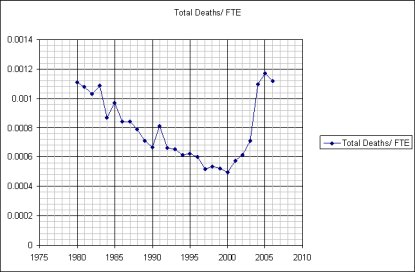The other day, I got an e-mail titled, "Statistics on Military Deaths," claiming to put into perspective the deaths caused by the Iraq War. It examines total military fatalities since 1980, showing that there were actually higher fatalities in the 80's than there are now, during the war. Since the information came in an e-mail forward, I was skeptical right off the bat, and decided to research it a little. The total death statistic is accurate, however, it's misleading in a number of ways - ignoring the causes of deaths, and ignoring the total number of people in the military over that time span. So, for anyone who's gotten this chain e-mail, I'm posting the reply I wrote to clarify it.
Here's the original e-mail that I received:
Below is some very interesting data referencing deaths in the military. I guarantee you will not read this in your local newspaper nor will you see it on the daily news broadcast. I pray this will encourage you to enlighten folks around you as to the brave and courageous young people serving in our military.
Deaths in the Military
1980 ......... 2,392
1981 ......... 2,380
1982 .......... 2,318
1983 .......... 2,465
1984 .......... 1,999
1985 .......... 2,252
1986 ......... 1,984
1987 .......... 1,983
1988 ......... 1,819
1989 .......... 1,636
1990 .......... 1,508
1991 ......... 1,7 87
1992 .......... 1,293
1993 ......... 1,213
1994 .......... 1,075
1995 .......... 1,040
1996 ............974
1997 ............817
1998 ...........826
1999 ............795
2000 ............774
2001 ...........890
2002 .......... 1,007
2003 ......... 1,410 [534*]
2004 ......... 1,887 [900*]
2005 .......... [919*]
2006 .......... [920*]
Figures so noted with an asterisk (*) indicates deaths as a result of Operation Iraqi Freedom and Operation Enduring Freedom. You may initially feel confused when you look at these figures--especially when you see that in 1980, during the term of President Jimmy Carter, there were 2,392 US military fatalities. What this clearly indicates is that our media and our liberal politicians pick and choose and tend to present only those facts that support their agenda driven reporting.
Another fact our left media and politicians like to slant is that these brave men and women losing their lives are minorities. Wrong again - The latest census shows the following:
European descent (white) ... 69.12%
Hispanic .... 12.5%!
African American .... 12.3%
Asian .... 3.7%
Native American ... 1.0%
Other ..... 2.6%
The fatalities over the past three years in Iraqi Freedom are:
European descent (white) ...74.31%
Hispanic.....10.74%
African American ... 9.67%
Asian ..... 1.81%
Native American ...1.09%
Other .... 2.33%
These statistics are published by DOD and may be viewed at: http://www.fas.org/sgp/crs/natsec/RL32492.pdf
God Bless America
Here's the reply that I sent back. I didn't do too much editorializing in my e-mail; I just let the facts stand by themselves. Note that for this blog entry, I'm putting smaller versions of the graphs, to fit the format of the blog, with links to the full size graphs. I also apologize for the headings to the tables - I had to make the font smaller so that they, too, would fit the format of the blog.
I've learned to be very skeptical of just about everything I get in e-mail, especially if it's politically motivated (whether from the left or right). So, I went and looked up the report this e-mail cited as it's source, and found that the e-mail was a bit misleading in the stats it reported. The total death number is listed in two tables in the report, which show the total number of military personnel, and breaks down the causes of death. It looks like the main driver behind higher deaths in the 80's was accidental deaths. Part of this was simply because there were more people in the military, and part of it was that there were more accidental deaths per capita then. Without doing some more research, I don't know whether the improved safety of the military now regarding accidental deaths is due to a specific initiative of the military, or a general trend for all jobs that include using dangerous machinery.
Anyway, here are the relevant tables from the report. Make of them what you will, but at least this gives a fuller picture than the e-mail.
http://www.fas.org/sgp/crs/natsec/RL32492.pdf
Table 4. U.S. Active Duty Military Deaths, 1980 Through 2006,
Part I, Total Military Personnel
|
| Calendar Year |
Active Duty (a) |
Full-Time(est.) Guard-Reserve |
Selected Reserve FTE (b) |
Total Military FTE |
Total Deaths |
| 1980 |
2,050,758 |
22,000 |
86,872 |
2,159,630 |
2,392 |
| 1981 |
2,093,032 |
22,000 |
91,719 |
2,206,751 |
2,380 |
| 1982 |
2,112,609 |
41,000 |
97,458 |
2,251,067 |
2,319 |
| 1983 |
2,123,909 |
49,000 |
100,455 |
2,273,364 |
2,465 |
| 1984 |
2,138,339 |
55,000 |
104,583 |
2,297,922 |
1,999 |
| 1985 |
2,150,379 |
64,000 |
108,806 |
2,323,185 |
2,252 |
| 1986 |
2,177,845 |
69,000 |
113,010 |
2,359,855 |
1,984 |
| 1987 |
2,166,611 |
71,000 |
115,086 |
2,352,697 |
1,983 |
| 1988 |
2,121,659 |
72,000 |
115,836 |
2,309,495 |
1,819 |
| 1989 |
2,112,128 |
74,200 |
117,056 |
2,303,384 |
1,636 |
| 1990 |
2,046,806 |
74,250 |
137,268 |
2,258,324 |
1,507 |
| 1991 |
1,943,937 |
70,250 |
184,002 |
2,198,189 |
1,787 |
| 1992 |
1,773,996 |
67,850 |
111,491 |
1,953,337 |
1,293 |
| 1993 |
1,675,269 |
68,500 |
105,768 |
1,849,537 |
1,213 |
| 1994 |
1,581,649 |
65,000 |
99,833 |
1,746,482 |
1,075 |
| 1995 |
1,502,343 |
65,000 |
94,585 |
1,661,928 |
1,040 |
| 1996 |
1,456,266 |
65,000 |
92,409 |
1,613,310 |
974 |
| 1997 |
1,418,773 |
65,000 |
94,609 |
1,578,382 |
817 |
| 1998 |
1,381,034 |
65,000 |
92,536 |
1,538,570 |
827 |
| 1999 |
1,367,838 |
65,000 |
93,104 |
1,525,942 |
796 |
| 2000 |
1,372,352 |
65,000 |
93,078 |
1,530,430 |
758 |
| 2001 |
1,384,812 |
65,000 |
102,284 |
1,552,196 |
891 |
| 2002 |
1,411,200 |
66,000 |
149,942 |
1,627,142 |
999 |
| 2003 |
1,423,348 |
66,000 |
243,284 |
1,732,632 |
1,228 |
| 2004 |
1,411,287 |
66,000 |
234,629 |
1,711,916 |
1,874 |
| 2005 |
1,378,014 |
66,000 |
220,000 |
1,664,014 |
1,942 |
| 2006 |
1,378,014 |
66,000 |
220,000 |
1,664,014 |
1,858 |
Source: Defense Manpower Data Center, Statistical Information Analysis Division, [url removed for web page formatting], accessed on June 27, 2007.
Notes: As of February 28, 2007 (reflects preliminary counts for 2006 and revised figures for 2004 and 2005).
a. Official Department of Defense end-strengths as of December 31 for military pay accounts. Excludes full time Guard and Reserve.
b. Full time equivalent (FTE) is based on official Department of Defense fiscal year end selected reserve strength (10% of the figure is used to estimate days on active duty).
|
Table 5. U.S. Active Duty Military Deaths, 1980 Through 2006,
Part II, Cause of Death
|
| Calendar Year |
Total Deaths |
Accident |
Hostile Action |
Homicide |
Illness |
Pending |
Self Inflicted |
Terrorist Attack |
Undeter- mined |
| 1980 |
2,392 |
1,556 |
|
174 |
419 |
|
231 |
1 |
11 |
| 1981 |
2,380 |
1,524 |
|
145 |
457 |
|
241 |
|
13 |
| 1982 |
2,319 |
1,495 |
|
108 |
446 |
|
254 |
|
16 |
| 1983 |
2,465 |
1,413 |
18 |
115 |
419 |
|
218 |
263 |
19 |
| 1984 |
1,999 |
1,293 |
1 |
84 |
374 |
|
225 |
6 |
16 |
| 1985 |
2,252 |
1,476 |
|
111 |
363 |
|
275 |
5 |
22 |
| 1986 |
1,984 |
1,199 |
2 |
103 |
384 |
|
269 |
|
27 |
| 1987 |
1,983 |
1,172 |
37 |
104 |
383 |
|
260 |
2 |
25 |
| 1988 |
1,819 |
1,080 |
|
90 |
321 |
|
285 |
17 |
26 |
| 1989 |
1,636 |
1,000 |
23 |
58 |
294 |
|
224 |
|
37 |
| 1990 |
1,507 |
880 |
|
74 |
277 |
|
232 |
1 |
43 |
| 1991 |
1,787 |
931 |
147 |
112 |
308 |
|
256 |
|
33 |
| 1992 |
1,293 |
676 |
|
109 |
252 |
|
238 |
1 |
17 |
| 1993 |
1,213 |
632 |
|
86 |
221 |
|
236 |
29 |
9 |
| 1994 |
1,075 |
544 |
|
83 |
206 |
|
232 |
|
10 |
| 1995 |
1,040 |
538 |
|
67 |
174 |
|
250 |
7 |
4 |
| 1996 |
974 |
527 |
1 |
52 |
173 |
|
188 |
19 |
14 |
| 1997 |
817 |
433 |
|
42 |
170 |
|
159 |
|
13 |
| 1998 |
827 |
445 |
|
26 |
168 |
10 |
161 |
3 |
14 |
| 1999 |
796 |
436 |
|
37 |
150 |
13 |
145 |
|
15 |
| 2000 |
758 |
398 |
|
34 |
138 |
|
151 |
17 |
20 |
| 2001 |
891 |
437 |
3 |
49 |
185 |
1 |
140 |
55 |
21 |
| 2002 |
999 |
547 |
18 |
51 |
190 |
6 |
160 |
|
27 |
| 2003 |
1,228 |
440 |
344 |
36 |
207 |
16 |
167 |
|
18 |
| 2004 |
1,874 |
604 |
739 |
46 |
270 |
19 |
188 |
|
8 |
| 2005 |
1,942 |
632 |
739 |
49 |
281 |
72 |
150 |
|
19 |
| 2006 |
1,858 |
465 |
753 |
30 |
205 |
238 |
155 |
|
12 |
Source: Defense Manpower Data Center, Statistical Information Analysis Division, [url removed for web page formatting], accessed on June 27, 2007.
Note: As of February 28, 2007 (reflects preliminary counts for 2006 and revised figures for 2004 and 2005).
|
Since I had to copy the data into Excel to make the tables, I figured I might as well plot them out, too. Here're graphs of the data, showing the general trend of decreasing military deaths, with the sharp increase starting in 2001. The first graph is deaths per Full Time Equivalent number of personnel, the second is just total number of deaths, broken down by category.


I didn't research the ethnicity claims, since the data cited in the original e-mail shows the numbers to be not too far off from the general make-up of the population, anyway.
Finally, and this is just a nit pick, but the e-mail said it was DoD that published the data, but cited a report from the Federation of American Scientists.
Like I said, I didn't do too much editorializing in that response. But, this is a blog, so you should have expected me to offer my opinions. Here they are.
The thing that bothered me the most from the original e-mail was the statement, "What this clearly indicates is that our media and our liberal politicians pick and choose and tend to present only those facts that support their agenda driven reporting." When the author of the e-mail could have just as easily copied two tables, they instead picked only one column out of those tables, and ignored all the other data (total number of personnel, causes of deaths) that put it into perspective, and then accused others of being biased. Now that takes some gall.
Second, what's the point they're trying to make? That this war hasn't caused a significant increase in the number of soldiers dying? Or is the point that it's okay that they're being killed in action now, because 25 years ago they would have just died in accidents, anyway. I think it's pretty clear, especially from the plotted graphs, that the wars in Iraq and Afghanistan have caused a substantial increase in the number of soldiers that would have been killed otherwise. You may think those numbers are acceptable, but don't pretend that they're not significant.
For another thing, this e-mail is only looking at deaths. How many people are being injured, and are now disabled, due to this war? Is it significantly higher than peace time? I don't know, and I haven't done the research, yet, but that's another big human cost.
This e-mail only tallies the deaths of U.S. soldiers. The cost in total human life is far greater than that. A report that came out in October of 2006 (over a year ago) estimated that more than 600,000 people died in Iraq than what would have happened had the U.S. not invaded (Washington Post article). That's a great deal higher than some estimates, but it's also the most scientific method I've seen of estimating the death toll, and the one I'd put my money on as being closest to the right answer. But even if you go by more conservative estimates, at the same time as that report came out, George Bush stated that over 30,000 civilians had died, the British-based Iraq Body Count research group estimated 50,000, and an Iraqi nongovernmental organization estimated 128,000 deaths between the invasion and July 2005. No matter which estimate is right, that's still a huge number of people dead.
Finally, I'll say that this e-mail completely ignored the financial burden of the war. I realize that it may seem a bit callous to start talking about money in relation to human lives, but the reality is that we live in a world of limited resources, and we have to choose where to apply those resources. Money that goes to support a war means that it isn't supporting other initiatives (such as research into alternative energy - a pretty important priority, I'd think, given the current path we're going on with global climate change).
I'm not going to use this entry to discuss the justifications or political outcomes of the war. I'm just going to say that no matter how you feel about those things, don't ignore that this war has cost us dearly.
Reference:
Fischer, Hannah, Kim Klarman and Mari-Jana "M-J" Oboroceanu. CRS Report for Congress: American War and Military Operations Casualties: Lists and Statistics. 29 June 2007. Congressional Research Service. [accessed 19 November 2007]



 Back in May, I wrote an entry,
Back in May, I wrote an entry,  I've written about this a
I've written about this a